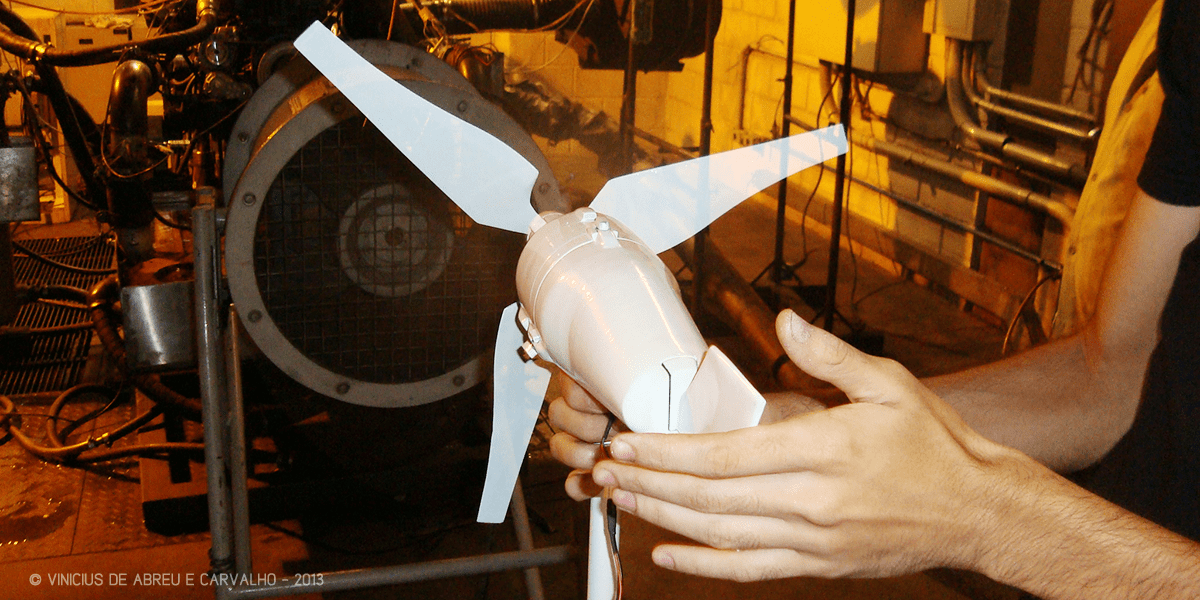

This project was developed at very end of a bigger project, called Polidesign, that dealt with the application of cutting edge technologies - 3d modeling, 3d printing and mutimedia visualization, specifically - as tools for empowering state high school students. The group of students involved with Polidesign would be teached in multiple creation fields, from 3d modeling to video making, the habilities acquired then being used to create educational material for their own school. While focusing at first in cellular biology, Polidesign was aiming to create material for other disciplines aswell. As an end-of-project assignment, our team - composed of biologists, product designers and architects - went about on what to do next. The theme "Propellers, Turbines and Blades", inserted in the context of renewable energies and centered in mechanical design and physics was chosen as most challenging and promising. The kickstart of this new direction was the design, build and testing of a functional portable wind turbine, here depicted.
This work was developed under the supervision and orientation of Prof. Antônio Valadão Cardoso, at the LMDM (Multimedia Educational Material Lab) facilities, at CETEC, Minas Gerais, Brazil.

DESIGN PROCESS


The gear system used in the wind turbine had to be possible to manufacture with the 3d printing technologies we used at the time (FMD and PVC sheet lamination). Also it was desired to keep all the axles collinear, reducing the profile of the nacelle (the aerodynamic body that encases all the mechanical and electric components) at the same time as providing decent RPM gain. A planetary gear system provided solutions to each of these requirements.


The nacelle interior was designed to be composed mostly of lightweight support structures where no moving pieces were used. Another important feature of these structures was that they had to be easy to remove and reinstall while keeping bearings, axles and the like aligned.
PROTOTYPING PROCESS

Here are depicted examples of the two prototyping technologies applied. The red part is made of ABS plastic through the deposition of several layers of a 0.4mm fused filament. This proccess is known as FDM (Fused Deposition Modeling) and the printer used was a RapMan 3. The white-yellow part is made of numerous layers PVC plastic 0.16mm thick sheet, cut and glued together by a Solido SD300 printer. This process can create parts with much better resolution and was used in the making of every gear in the turbine.

The various stages of sanding and priming of the printed parts.

A just-printed (left) and a roughly sanded propeller blade (right). The blade had to printed standing and was almost too tall to fit in the RapMan.
FINISHED PROTOTYPE

The anterior nacelle and its internal structures. The bearings shown here (and then used on the tests) were also printed from PVC as a workaround to a last-minute issue with the real ones.

The central portion of the nacelle with its three aligning channels and the sun gear, planet gears and carrier already assembled.

A comparison between the designed part and its prototyped counterpart. Pretty close.

The posterior nacelle is shown here with the rudder and internal structures completely disassembled. The electric motor shown was the very one used on the tests.

Propeller hub and blades. Different blades can be fitted on the same hub as to test different pitches and shapes.

The assembled propeller and the very noticeable pitch of the blades.

Propeller hub assembled. Remeber the sanding and priming stages? All the shine you see comes from that elbow grease intensive phase.

We simulated various levels of wind using an industrial level blowing fan.

A simple electronic circuit was put together to give us qualitative measurements of the turbine's output. No voltage booster was used. The photo shows the bargraph state when the propeller is at around 200 RPM.

The same circuit from the previous photo encased and ready for testing.

Results after a evaluational-turned-destructive testing.
Having achieved an estimated 540 RPM and lighting the bargraph, the turbine was taken to its limit. At around 1000 RPM one of the blades, which had been broken and repaired beforehand, snapped in two. Our guess is that with no defective elements, a 3D printed wind turbine of these proportions and make could handle even more.

